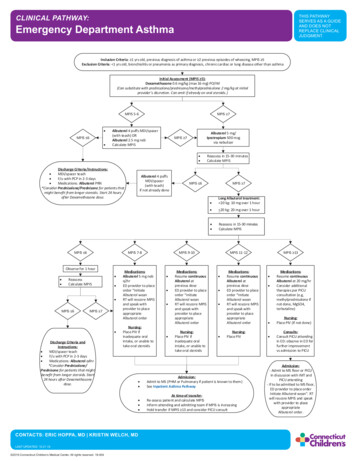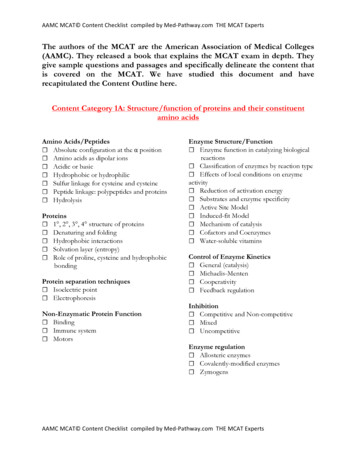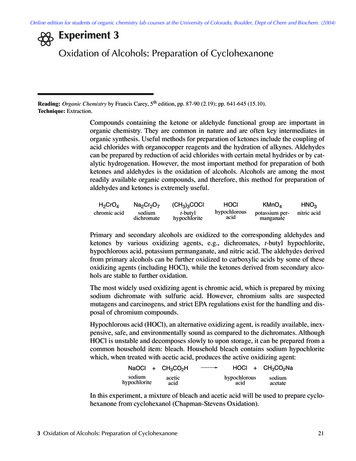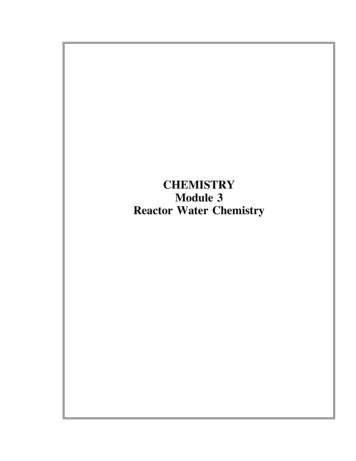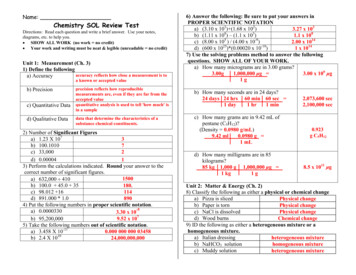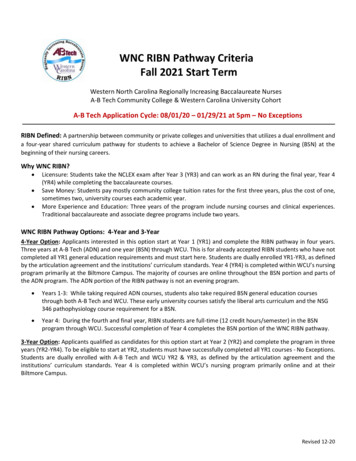
Transcription
MCAT Prep Med-Pathway.com Organic Chem Review The MCAT ExpertsORGANIC CHEMISTRY REVIEWAt Med-Pathway, we love Organic Chemistry (O Chem) and so does theMCAT. OChem provides a very good foundation for understanding variousaspects of medicine including biochemistry, drug development, and drugdesign. Med-Pathway’s very own Dr. Phil Carpenter studied O Chem under theworld famous Dr. Bruice at UCSB and was a Master Trainer and Teacher forMCAT Ochem for years.We present a comprehensive subject review. The website has nearly 100challenging assessment questions/passages to prepare you for O Chem masteryon the MCAT. Med-Pathway O Chem Review has been derived from a carefulconsideration of the AAMC MCAT Content Guideline. Stereochemistry andAmino Acids and Proteins are discussed in detail in other subject modulesavailable on the website. This module is divided into three sections. Thefollowing topics are discussed and assessed in each chapter of this module.Chapter I Carbon: Bonding, Hybridization, and Saturation Induction and Resonance General Nomenclature Alkanes (Free radical halogenation, Conformation of cycloalkanes) Alkenes Alcohols (Nomenclature, Physical Properties, Acidity, Synthesis,Oxidation, SN1 and SN2 Substitution Reactions, Preparation of Mesylatesand Tosylates, Protection of Alcohols Carbonyl Chemistry: Aldehydes & Ketones (Physical Preparation &Synthesis, Oxidation-Reduction, Keto-enol tautomerization, Aldolcondensation reactions, kinetic & thermodynamic enolates, formation ofacetals & hemiketals) CyanohydrinsCHAPTER ICarbonCarbon is central to organic chemistry. The stability of carbon-carbon bonds isan essential reason carbon is a major ingredient in important biopolymers suchas proteins, nucleic acids, and polysaccharides. Because carbon is an electroMCAT Prep Med-Pathway.com Organic Chem Review The MCAT Experts
MCAT Prep Med-Pathway.com Organic Chem Review The MCAT Expertsneutral atom, its bonding to more electronegative atoms generates polar bonds(dipoles) that formulate potential sites of chemistry. We will see this point overand over.With an atomic number of six, carbon has four electrons that participate in thegeneration of covalent bonds as shown below. Recall that the orbitals ofvalence electrons combine to form new hybrid orbitals. Be familiar with howhybridization of orbitals and molecular shapes are related.Single bonds are known as sigma bonds (σ) and double bonds are also called pibonds (π) bonds. A double bond contains one σ and one π bond. A triplebond contains one σ and two π bonds.There are a few points regarding hybridization that are important to know:1) The greater the s character, the greater the bond dissociation energy.2) The greater the s character, the shorter and stronger the bond.3) Therefore, carbon-carbon triple bonds are shorter than double bonds, butrequire more energy to dissociate as they have higher bond dissociationenergies.4) Acidity is inversely proportional to s character. Thus, the hydrogen atoms inacetylene (C2H2), a molecule that has a triple bond, are more acidic than thehydrogen atoms in ethylene (C2H4), a molecule that has a single double bond.Degrees of unsaturationThe number of double bonds and/or rings in a compound is referred to as itsdegrees (or units) of unsaturation. This can be figured out given the molecularMCAT Prep Med-Pathway.com Organic Chem Review The MCAT Experts
MCAT Prep Med-Pathway.com Organic Chem Review The MCAT Expertsformula of the compound. Remember that all hydrocarbons have an evennumber of hydrogen atoms, otherwise they have charged carbon atoms ( or -)or free radicals.Saturated compounds are those that contain only sigma bonds and have allcarbons with a maximal number of bonded hydrogen atoms (2N 2 where N the number of carbons atoms). A general formula for the degrees ofunsaturation of a compound can be described as:Degrees of unsaturation 2N 2 –X/2whereC # of carbon atomsN # of hydrogen atomsX # HalogensH # Hydrogen atoms# Oxygen atoms 0And nitrogen atoms n n 1, x x 1Using this formula, the number of units (degrees) of unsaturation of benzene(C6H6) can be calculated as:Degrees of unsaturation 2N 2 –X/22(6) 2 -6/2 4 units of unsaturation. This should make sense as benzenehas one ring and 3 double bonds.Chemical InductionIn chemistry, induction refers to the uneven distribution of electrons within asigma bond. Although bonds are usually depicted in Lewis dot structures aswell as stick structures as equally sharing electrons, the transmission of chargethrough dipoles often unequally distributes electrons. Such polarization ofelectrons (i.e. induction) within bonds is largely determined bythe electronegativity of the participating atoms. The strength of inductivegroups depends on distance from the group and the atom that it is acting on.MCAT Prep Med-Pathway.com Organic Chem Review The MCAT Experts
MCAT Prep Med-Pathway.com Organic Chem Review The MCAT ExpertsThe image below shows some important examples of induction. PanelA shows water and the carbonyl unit. Note the presence of the electronegativeoxygen atoms bound to either hydrogen (water) or carbon (carbonyl). Asoxygen is more electronegative than either hydrogen or carbon, the electrons inthe bond are not shared equally, resulting in dipole moments. This is reflectedin the partial positive and negative charges.Panel B shows three carbocations (tertiary, secondary, and primary). Incontrast to oxygen, alkyl groups donate their electrons through induction. As aconsequence, tertiary carbocations are more stable than secondary and primarycarbocations as the relative induction of electrons reduces the overall positivecharge on the carbon. Recall that carbon is electro neutral and more stablecarbocations have charges more towards neutrality.Panel C shows chlorinated derivatives of acetic acid. As chlorine is anelectronegative halogen, it will draw electrons towards itself, even overdistances. Notice that the pKa of acetic acid is normally 4.86, but decreases as afunction of the number of chlorine atoms added to the molecule increases. ThepKa of trichloroacetic acid is 0.7. This is due to the inductive effects ofchlorine. As more electron withdrawing groups are added to acetic acid, the OH bond becomes more acidic and more capable of releasing the proton.MCAT Prep Med-Pathway.com Organic Chem Review The MCAT Experts
MCAT Prep Med-Pathway.com Organic Chem Review The MCAT ExpertsResonanceThe structure of molecules is commonly described through Lewis structures.However, some molecules can be drawn with more than one Lewisstructure. In some cases, delocalized pi electrons exist as resonance hybridstructures and can be described through multiple Lewis structures. Importantly,each form contributes in proportion to the overall stability of themolecule. Resonance structures are not transient states, but rather the truemolecular structure is the resonance hybrid and this structure represents theoverall lowest total energy.Therefore, resonance is important for molecular stability. The resonancestructures for benzene (C6H6) are shown. Note that two resonance structuresof benzene can be written in the Lewis dot format. As written, benzene hasboth single and double carbon-carbon bonds, but the average bond length forthe carbon-carbon bonds in benzene falls in between what is expected forsingle and double bonds (see image). That is, the bond lengths in benzene arein between single and double bonds due to resonance delocalization of the piMCAT Prep Med-Pathway.com Organic Chem Review The MCAT Experts
MCAT Prep Med-Pathway.com Organic Chem Review The MCAT Expertselectrons. Note that the pi electrons can move from one space to another, butthe atoms themselves do not move. This is shown for aniline.Notice that in the resonance structures of aniline, the negative charges are inthe ortho and para positions and this explains why addition of groups to anilineoccur at these two positions.The basic rules for determining the most optimal resonance structuresare as follows:1) Maintain the octet rule for atoms2) Minimize formal charges, but electronegative atoms prefer negative charges3) Maintain aromaticity4) Minimize formal charges5) Minimize separation of chargesNomenclatureCommon and IUPAC names will be used on the MCAT. The general rules areas follows:A) Count the longest continuous carbon chain.B) Assign numbers to carbon atoms in the chain such that the sum of theattached substituent groups is the lowest.C) Name the substituent groups.D) Name the compound using substituent groups in alphabetical order.In some cases, the functional groups can be named as the parental compoundin terms of the substituents.MCAT Prep Med-Pathway.com Organic Chem Review The MCAT Experts
MCAT Prep Med-Pathway.com Organic Chem Review The MCAT ExpertsLet’s examine some examples. More will be presented as the chemistry of eachfunctional group is discussed.Organic compounds contain a large array of functional groups. Alkanes,alkenes, and alkynes differ in the number of double bonds between carboncarbon covalent bonds. The following functional groups will appear on theMCAT and will be discussed here. Other groups such as alkenes and ethers willalso be examined. Alkynes are rare in biological systems and do not appear tobe naturally present in humans.MCAT Prep Med-Pathway.com Organic Chem Review The MCAT Experts
MCAT Prep Med-Pathway.com Organic Chem Review The MCAT ExpertsALKANESSaturated hydrocarbons are known as alkanes and have the formula of:CNH2N 2They are relatively unreactive, but undergo two significant reactions:A) Combustion reactions. In the presence of heat and oxygen, alkanes areoxidized to CO2 and H2O. These exothermic reactions release a lot of heat.Think of burning gas in your car.B) Free radical substitutionAlkanes can be halogenated in free radical reactions. The resulting alkyl halidesare often used further as substrates in additional reactions. Free radicals arehighly reactive molecules. The reaction occurs in the presence of light or heatMCAT Prep Med-Pathway.com Organic Chem Review The MCAT Experts
MCAT Prep Med-Pathway.com Organic Chem Review The MCAT Expertsto induce homolytic dissociation of the diatomic halogen. All free radicalreactions occur with three major steps:1) Initiation 2) Propagation 3) Termination. Shown in the figure is the freeradical chlorination of methane, the simplest alkane.Initiation: The diatomic chlorine molecule is split in a homolytic fashion bylight or heat. Homolytic cleavage generates free radical chlorine atoms thatcontain one unpaired electron. Note that initiation increases the number of freeradicals in the system.Propagation: This occurs in two steps. The methane alkane interacts with thefree radical chlorine atom. A hydrogen atom is taken from the alkane,generating a primary, free radical intermediate and another chlorine free radical.This initiates a chain reaction. In the second step, the alkyl free radical collideswith a diatomic chloride molecule forming the alkyl halide and another chlorideradical.Termination: Any reaction that decreases the number of free radicals in thesystem is a termination event. Two termination reactions are shown above.MCAT Prep Med-Pathway.com Organic Chem Review The MCAT Experts
MCAT Prep Med-Pathway.com Organic Chem Review The MCAT ExpertsStereochemistry in Free Radical HalogenationFree radical halogenation reactions often produce stereoisomers. Before weexamine a specific example, let’s review some basic tenants of stereoisomers.Isomers that differ in their 3D-spatial arrangement of atoms aretermed stereoisomers. Any molecule that cannot be superimposed on its mirrorimage exhibits chirality. The simplest way to envision chirality is to note thatyour left hand cannot be superimposed on your right hand: they are mirrorimages of each other. Chirality refers to “handedness” and exists throughoutnature. Helices in nucleic acids and proteins have handedness. Thus, chirality isa term referring to handedness or symmetry, and is an intrinsic property irrorimagearecalled enantiomers. The two enantiomers of the amino acid alanine are shownbelow. The red asterisk designates the chiral carbon stereocenter. The twomolecules are non-superimposable mirror images. Enantiomers possessidentical physical properties (i.e. boiling and melting points) with the exceptionof how they interact with light. This is further elaborated on in the MedPathway Stereochemistry and Isomers Testing Module. A 1:1 mixture ofenantiomers is called a racemic mixture. Any ratio of enantiomers deviatingfrom 1:1 is called a scalemic omsor stereocenters. According to Mislow and Siegel, a stereocenter represents aposition in a molecule where the exchange of two groups generates astereoisomer. Stereocenters are often referred to as chiral or asymmetriccenters. Although many atoms can exhibit chirality, the MCAT will largely, ifnot exclusively, focus on carbon.MCAT Prep Med-Pathway.com Organic Chem Review The MCAT Experts
MCAT Prep Med-Pathway.com Organic Chem Review The MCAT ExpertsThe free radical chlorination of butane generates a racemic mixture of 2chlorobutane. Note that butane can generate both primary and secondary freeradicals. Because secondary free radicals are more stable than primary freeradicals, the predominant products will substituted at position 2. For a freeradical halogenation reactions, the image below shows the generation of thefree radical intermediate after abstraction of the secondary hydrogen.Importantly, this intermediate is planar, meaning that in the second step, thechlorine free radical can react from either the top or the bottom of the plane.As a result, two products are created with equal probability. Note that theproduct is chiral as the carbon at the reaction center has four differentsubsti
MCAT Prep Med-Pathway.com Organic Chem Review The MCAT Experts MCAT Prep Med-Pathway.com Organic Chem Review The MCAT Experts neutral atom, its bonding to more electronegative atoms generates polar bonds (dipoles) that formulate potential sites of chemistry. We will see this point over and over.

